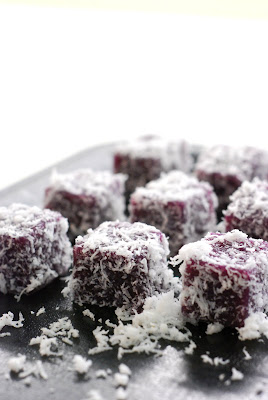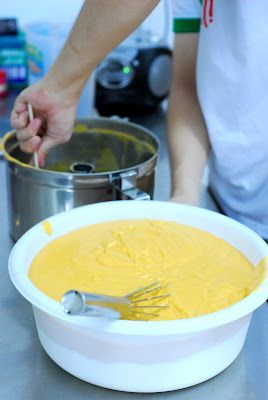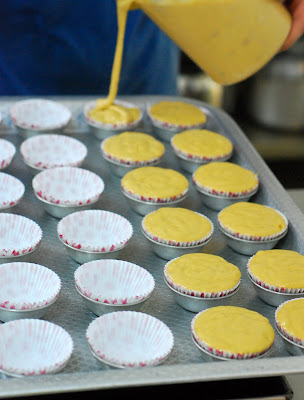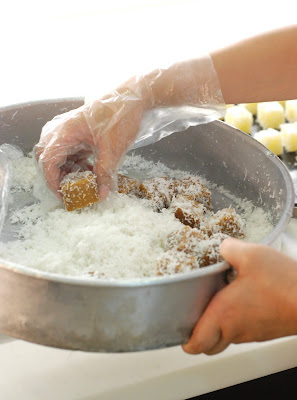 Trays of gula meleka kueh kosui squares, dusted with dessicated coconut and ready to eat
Trays of gula meleka kueh kosui squares, dusted with dessicated coconut and ready to eat
I have some really exciting and delicious pictures to share. My friend Sharon gave me a creative and generous birthday present, I was allowed to spend a morning with the chefs at her family's three-generation kueh kitchen. The definition of "kueh" in the dictionary reads: (Cookery) (functioning as singular or plural) (in Malaysia) any cake of Malay, Chinese, or Indian origin, which isn't particularly helpful. I would instead say that "kueh" refers to a multitude of traditional desserts or sweets, made most typically from tropical pastes like green bean, mung bean, peanut, coconut or gula melaka (palm sugar) and baked, but most often steamed, in skins of rice flour, sweet potato or a similar carbohydrate-based dough.
 These kueh keledik are made from seasonal purple sweet potatoes, instead of regular orange sweet potatoes (the name for both sweet potato based kueh is the same). These were a big hit with their unique colour and piquant flavour.
These kueh keledik are made from seasonal purple sweet potatoes, instead of regular orange sweet potatoes (the name for both sweet potato based kueh is the same). These were a big hit with their unique colour and piquant flavour.
 Trays of kueh, sliced and whole, waiting for sale
Trays of kueh, sliced and whole, waiting for sale
The process of making kueh is extremely tiring and time-consuming. In fact, it really is a dying art as few places make these sweets in a home-made and wholesome way. Certainly, the well-known commercial stores (as evidenced by their ingredient lists) do not. Harriann's Delights, still makes all their kueh in the traditional way, with all-natural ingredients. The riot of colours that you see here are all from the ingredients themselves and everything is made fresh.
 The implements of the trade
The implements of the trade

 Grinding sweet potato into a puree, mixed with tapioca flour, for the kueh keledik
Grinding sweet potato into a puree, mixed with tapioca flour, for the kueh keledik
Although I was quite clear that working in commercial food operations is not easy, it wasn't till I was standing in the stiflingly steaming, bubbling kitchen, that I realized how daunting the heavy lifting, pouring, stirring, the mechanical, chemical action that goes into rendering kueh is and why most young people and home cooks wouldn't appreciate the hard work and scale of this Gargamel's lair. There was absolutely no worry that I could pinch recipes, most of the chefs had memorized the process and had simplified the proportions into large pack sizes.
 Sharon looks remarkably cheerful for a bright and early Saturday morning.
Sharon looks remarkably cheerful for a bright and early Saturday morning.
 Blending the rice flour and potato for ondeh ondeh
Blending the rice flour and potato for ondeh ondeh
I myself love kueh, particularly ondeh-ondeh (balls of juicy, liquid gular meleka wrapped in thin potato flour skins, kueh dadar (gula melaka-drenched shaved coconut, wrapped in a thin pandan pancake) and kueh salat (a two-layered cake sandwiching a steamed coconut jam, known as kaya, against glutinous rice, stained at the fringe with the blue colouring from a tropical flower known as the bunga telang) but I am definitely one of the new-generation that don't dedicate myself to making kueh anywhere as often as I make Western dessert.
 Pouring out the batter for huat kueh into papered moulds. Huat kueh (Hokkien) or fatt gou (Cantonese) translates as 'properity cake', "huat" meaning alternately 'to distribute', 'to explode- with reference to its cracked surface after steaming' or 'luck' and 'to strike riches'. These cakes are most often brown from gula meleka but also white or pink and decorated with a red dot when used for prayers during religious or New Year seasons.
Pouring out the batter for huat kueh into papered moulds. Huat kueh (Hokkien) or fatt gou (Cantonese) translates as 'properity cake', "huat" meaning alternately 'to distribute', 'to explode- with reference to its cracked surface after steaming' or 'luck' and 'to strike riches'. These cakes are most often brown from gula meleka but also white or pink and decorated with a red dot when used for prayers during religious or New Year seasons.
Arriving at 8am, I had already missed the 3am shift to rice potatoes, grind palm sugar, sieve sugarcane juice and the like, for the morning sales at the wet market. These kitchen preparations were for their more modern store at Jalan Bukit Merah and moved at a slower pace, allowing Sharon and I to dabble in new ondeh-ondeh flavours toward the later morning. The chefs were really gracious, if a little amused in answering my many questions.
 Waterchestnut kueh, made from cooking diced water chestnut with fresh sugarcane and water chestnut powder, then spread, cooled and sliced into fat squares.
Waterchestnut kueh, made from cooking diced water chestnut with fresh sugarcane and water chestnut powder, then spread, cooled and sliced into fat squares.
 A close-up of the waterchestnut kueh, I just love its verdant colour, springy texture and the cool refreshing sweetness of the sugarcane with the crunchy turgid chestnut pieces. I thought this would be a very adult kueh but strangely, children really warm to it.
A close-up of the waterchestnut kueh, I just love its verdant colour, springy texture and the cool refreshing sweetness of the sugarcane with the crunchy turgid chestnut pieces. I thought this would be a very adult kueh but strangely, children really warm to it.
Growing up in Singapore, I've been lazy about seeking out or appreciating kueh as often as other desserts. I'm also quite a terrible snob about kueh, refusing to fatten myself on pedestrain versions. Here's an example of what I mean- when making Kueh Salat, the kaya, or coconut jam, requires many hours of continous stirring by the stove to naturally thicken and smoothen the coconut, pandan and egg mixture. The commercial method is to introduce a thickener, like flour or gelatin.
The other common cheat is a big tablespoon of blue food colouring, which produces an inky, navy Smurf-esque colour, as opposed to the gentle cornflower blue of crushed bunga telong. The liquid food colouring will also have a messy application, as it inveriably seeps deep into the rice layer, leaving tell-tale patches and sometimes, a layer of soaked-soggy rice. Also, if the glutinous rice is hard or dry, it is a sign that the grains were not soaked overnight and froze up when cooked. I can't tell you how many of these I've been served, with insistences of "it's good, it's good!". The problem with sub-par kueh recipes is, it's just floury coconut on dried rice, steamed with blue food colouring- ain't no magic in that!

 The trays of steamed kueh reminded me of those National Geographic photographs of clothing dye in India. These are kueh salat, yam, sweet potato and gula meleka kueh kosui.
The trays of steamed kueh reminded me of those National Geographic photographs of clothing dye in India. These are kueh salat, yam, sweet potato and gula meleka kueh kosui.
I've often felt therefore, that the gap between good and average kueh is very discernible, unlike in Western desserts, where small fluctuations in texture are tolerable, even sometimes, negligable, given the heat and chemical reactions the baking process. They may make the difference between sublime and excellent but barring big flaws, as long as the cream is not sour, the sponge not collapsed and the chocolate not hydrogenated fats, the natural sweetness of most Western desserts covers up many flaws and satisfies the sugar high to end a meal. The variability of cakes allows them to be coarse, or fine, dense or aerated.

 Tossing cubes of gula meleka kueh kosui in fresh, dessicated coconut.
Tossing cubes of gula meleka kueh kosui in fresh, dessicated coconut.
The hallmark of kueh on the other hand, is refined consistency and the ingredients in kueh are very savoury. We all know what happens if potato is boiled too long, or inadequately steamed. A sub-standard kueh has a terrible and obvious mouth-feel, it is too hard, too thick or grainy or worse, too suddenly-crunchy or runny within. It tastes like it was stained by a sour streak of yesterday's curry gravy, or made with masses of ground horse-hoof powder. Somtimes I am convinced that it is this narrow margin of error, combined with the tediousness of the process, that has led to the decline of kueh's popularity amongst home-cooks and consumers.
 Original ondeh-ondeh, dusted with fresh dessicated coconut. The store also makes chocolate ondeh-ondehs and durian ondeh-ondehs on special order.
Original ondeh-ondeh, dusted with fresh dessicated coconut. The store also makes chocolate ondeh-ondehs and durian ondeh-ondehs on special order.
 These were the flavours that we experimented with, I made original gula meleka ondeh-ondeh, salted caramel ondeh-ondeh and ondeh filled with cheese (and raspberry cheese), then tossed in grated parmesan cheese. It isn't as easy as it looks to roll the fillings within the thin dough. Some of the ondeh-ondeh balls leaked when swirled in boiling water and we needed to use more solid paste or cheeses!
These were the flavours that we experimented with, I made original gula meleka ondeh-ondeh, salted caramel ondeh-ondeh and ondeh filled with cheese (and raspberry cheese), then tossed in grated parmesan cheese. It isn't as easy as it looks to roll the fillings within the thin dough. Some of the ondeh-ondeh balls leaked when swirled in boiling water and we needed to use more solid paste or cheeses!
Thankfully, I've now been inspired and educated (not to mention hugely entertained) by my morning in the kueh kitchen and Sharon's family is holding the fort on this cultural food and remain dedicated to their craft. The Tans have been in this trade for the last two decades, prior to Harry and Ann’s involvement, the former’s mother, Madam Chia Ngak Eng, ran the stall at Tiong Bahru for more than forty years.


In the last decade, Madam Chia handed over the operation to Harry, which marked the birth of HarriAnn’s Delights. He has since adopted his mother’s traditional recipes and even improved some of them to cater to the palates of the modern customer, while remaining true to the standards of fresh ingredients, daily production, personal preparation and customer service.
 The fruits of our labour, literally
The fruits of our labour, literally
Apart from kueh, they also make other authentic treats like glutinous rice with boiled peanuts and fried shallots, pumpkin and yam cakes and traditional new year cookies. What I really like about their product is that their prices, at $2 for 5 ondeh-ondeh, make it very reasonable to order a large tasting selection of kueh or party platters for guests. If you're interested in an order, call Sharon at 97492311.
Harriann's Delights
30 Seng Poh Road,
#02-25, Tiong Bahru Market
Open from:
Tuesdays to Sundays, 6am to 2pm
Blk 146, Jalan Bukit Merah #01-1092
Tel: +65 6273 0852
Fax: +65 6273 0825
Open from:
Tuesdays to Saturdays, 7am to 4pm
Sundays, 7am to 3pm
www.harrianns.com





























